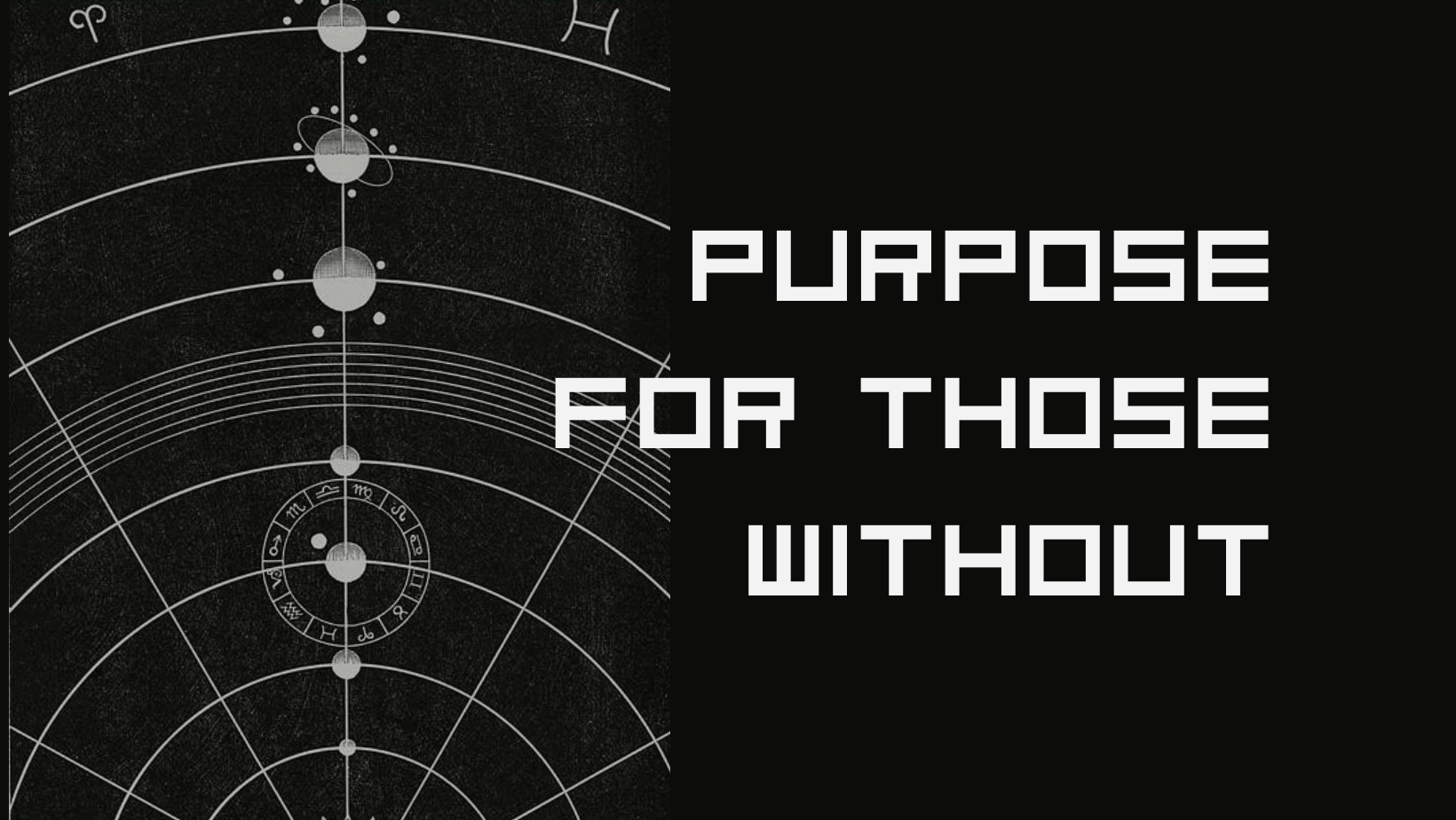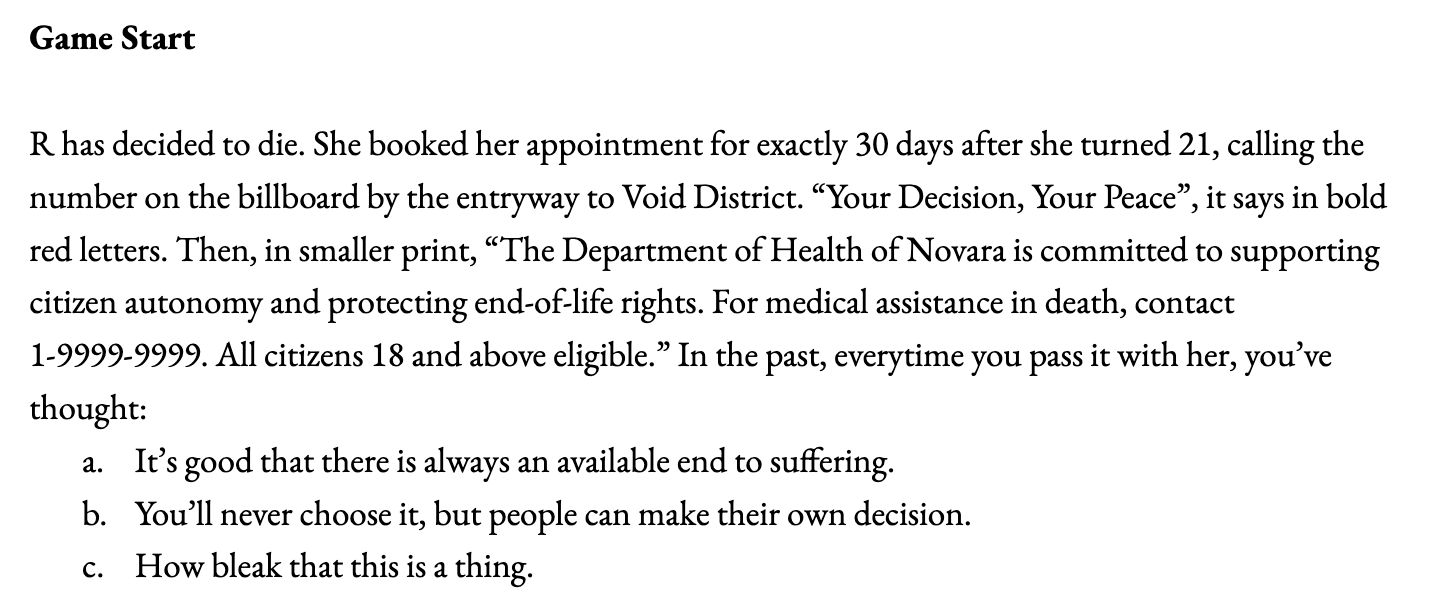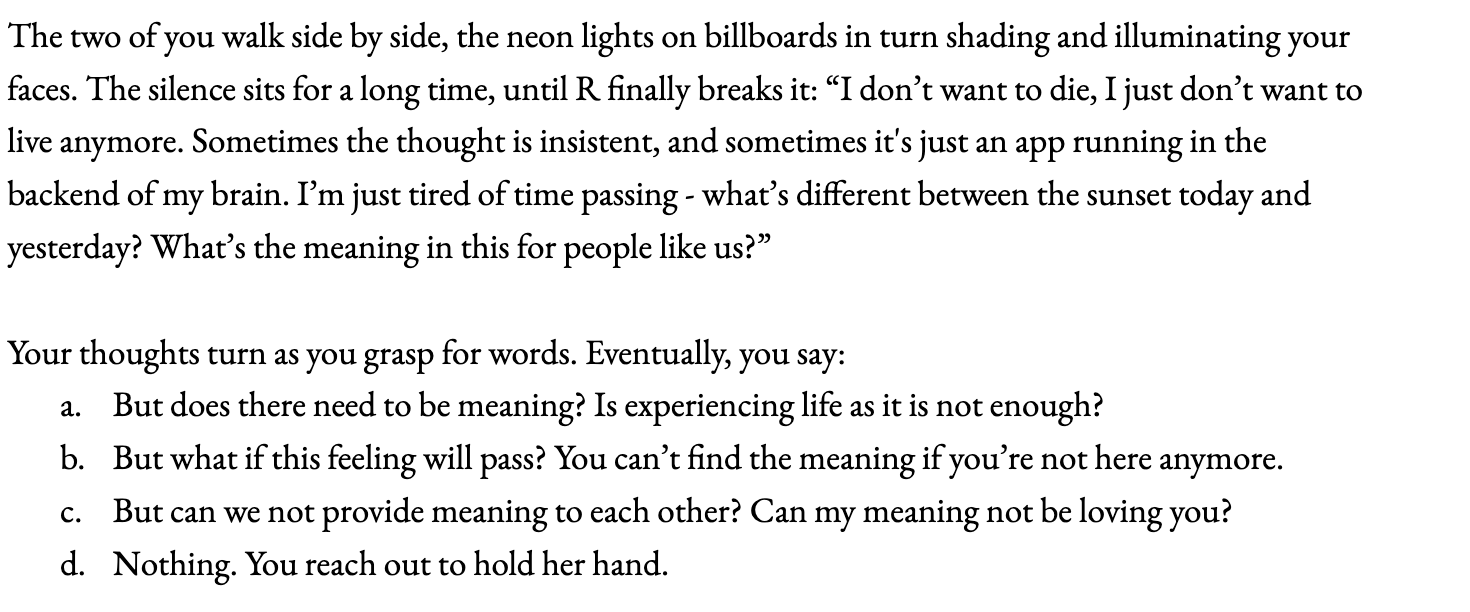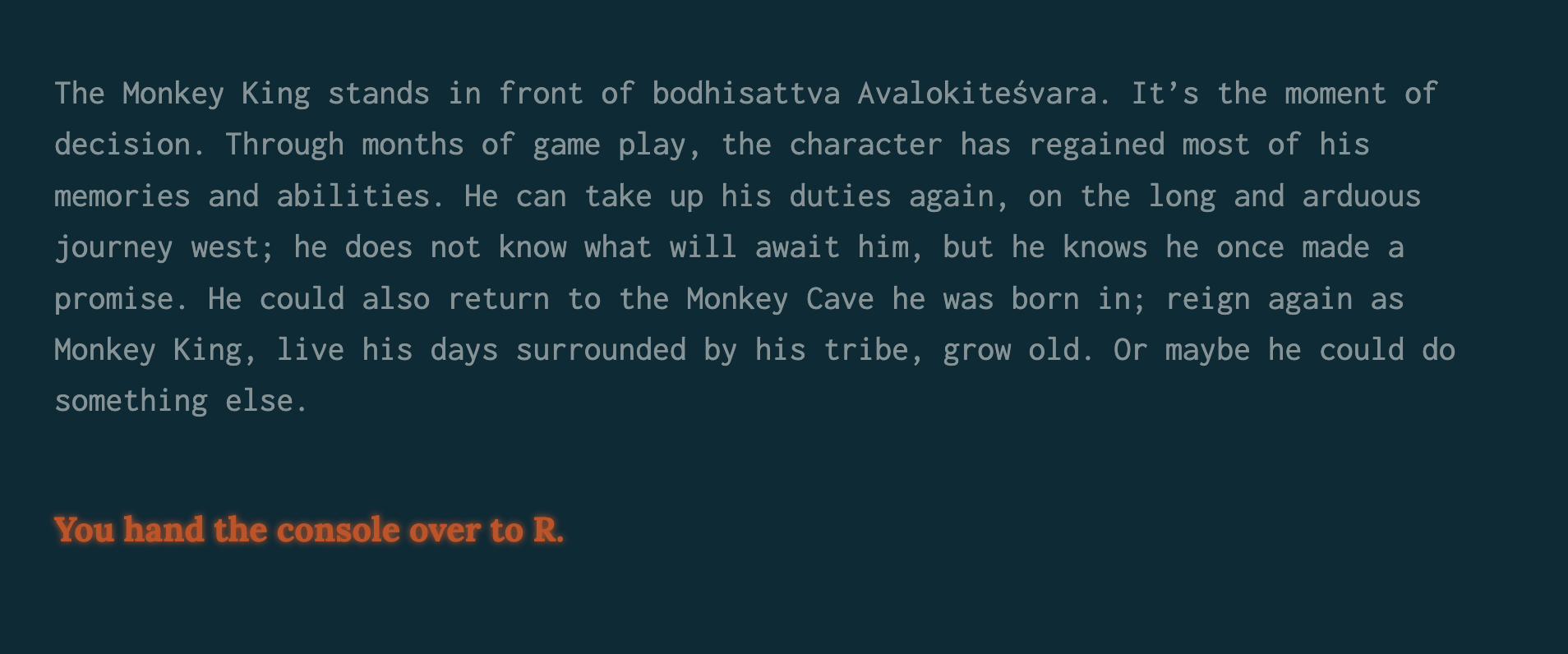
The Game
Play at: https://tinglin.itch.io/purpose-for-those-without
Password: cs377g
**Content Warning: suicide, mental health**
Overview & Purpose
This game began with three disparate but related threads of thought. The first is the idea of obsessing over “finding the right words”, in the context of saving a friend from suicide. I think it was what interactive fiction first reminded me of: that urgency at every turn to hope that you are making the right choice, triggering the right mechanics that will lead to an acceptable ending.
The second comes from Fanon’s critique on colonial psychiatry, as well as this quote from Kurt Vonnegut: “Workers in the field of mental health at various times in different parts of the world must find themselves asked to make healthy people happier in cultures and societies which have gone insane.” The idea is mental unwellness is the natural, rational response to an oppressive world.
The third is a concern over Canada’s medical assistance in dying (MAID) law, one of the world’s least stringent. Critics have alleged that assisted suicide is being recommended to disabled, mentally ill and other marginalized people who might instead benefit from adequate social services that improve their quality of life.
Purpose for Those Without is my own mediation on these three threads of thought, though mainly centered around the first. The premise of the game is a dystopia where a government funds assisted dying in lieu of social services while the 99% commit suicide en masse, not seeing a viable future. When R, the protagonist’s best friend, makes the same decision, the player must try and save her. The game mostly unfolds as an extended conversation, with some action and in-game game-play interspersed.
Initially, I was inspired by games such as Creatures Such as We, which I think give the player a chance to reflect on their own beliefs surrounding authorial intent, the meaning of art & its ownership, the nature of games, and more. The choices provided in the game aren’t ever “right” or “wrong” – you won’t end up in a “good” and “bad” end state – but rather serve as an interface between the player and the philosophical questions posed by the author/game. I really wanted to use Purpose for Those Without to tease apart some of my own thinking on (assisted) suicide and meaning. I researched several philosophical schools of thought’s (i.e. Utilitarianism, Liberalism, Idealism) conceptualizations of suicide, and I wanted to capture some of that ambiguity in thinking.
As the game developed, it also became more personal & meta, and I wanted to question the act of using games to embody and work through a personal experience.
Iterations
Iteration 1
In the first prototype, I focused on world-building and set up. I also wanted to sketch down some key decisions and shape what the dialogue choices might look like. It was very important to me that this game didn’t explicitly define “good” and “bad” things to say in response to R; I didn’t want the takeaway to be that saying the “wrong” thing to a suicidal friend would contribute to their decision in any way. I didn’t want to impose any kind of value judgment; it was more important to me that the choices shaped the subsequent conversation and provoked some reflection within the player relating to their own attitudes towards death, suicide or “purpose”.
Here are some screenshots of the very first drafts, written in Google doc:


Because the game was very incomplete, during playtesting I focused on asking questions about the premise, the writing and the overall directions of the game.
Playtest #1 (in class, 1 college-aged male, 2 college-aged females from CS377G)
- Playtesters enjoyed the writing; all thought preliminary world-building was successful
- The dialogue choices seemed realistic; playtester 1 noted that they liked how it didn’t impose a value judgment
- Playtesters questioned how game would branch out, wanted choices/end state to feel impactful
- One playtest expressed that they thought being there for the friend should be important and should affect the end state
- Playtesters had questions about whether the end state (R’s fate) would change based on player choice; thought it would be too depressing if all paths led to the same ending
- Playtesters thought it could be cool if entire game was just one conversation
- Confusion over the introduction of the in-game game
Some changes I felt I had to make:
- Decide how choices would be meaningful – create dialogue trees that branched out depending player choice
- Have ending be ambiguous, instead of a uniform “fail” or “success” state with respect to R’s decision
- Flesh out how the in-game game related to the message of the overall game
Iteration 2 
In this version, I moved most of the writing over to Twine. The storylines were relatively limited and several choices led to the same passages/were dead-ends. However, the flow was mostly complete front to end. This version roughly sketched out how the in-game game was related to the overall message by having it featured in two critical moments: the moment where the player tries to understand the motive of R, and the ending where the player hands over the console to R. The narrative progressed relatively linearly, with the only points of branching out being the player’s initial attitude towards assisted suicide and the conversation between the player and R. There was a sidebar that allowed players to backtrack.

I did four rounds of playtesting, two in class (2 different class periods!) and two outside of class.
Some feedback I received:
Playtesting #2 (in-class; college-aged male)
- Player went through passages really fast; maybe not enough incentive to read through paragraphs right now
- Player felt the story short and well contained; they liked the length and felt like there weren’t too much extraneous talking, which made the choices feel more impactful since there weren’t many chances to stay stuff
- Game felt personally impactful, options felt realistic
- The in-game game seemed a bit disconnected from overall story
- Doesn’t feel like there is a clear intended message, feels more like a neutral viewpoint towards the system of assisted suicide
Playtesting #3 (in dorm, college-aged male)
- Player enjoyed the writing, felt the narrative was strong and the dialogue was good
- The balance between “slides” with choices and those without felt off; there were too many stretches that didn’t contain any choices and it felt monotonous
- Felt like their attitude towards suicide weren’t probed enough, because R’s story didn’t feel sufficiently fleshed out
- R’s dialogue did not feel super receptive to player choice, felt like she would’ve responded similarly regardless of what the player chose to say
- Connection between the in-game game and the actual game felt a bit forced due to writing “overselling” it; could’ve let player do more work to figure it out
- The governmental critique felt very secondary
Playtesting #4 (in dorm, college-aged male)
- Worldbuilding was sufficient
- Confused by the in-game game at first, though got the connection eventually
- Certain dialogue choices felt unnatural (“I just wouldn’t say that”); seemed too hurtful
- Felt the game was more meaningful to people who’ve had similar experiences
- Felt the sidebar (the option to go back) made the choices felt less significant, because there was always the option to re-choose
- The length was good
Playtesting #5 (in-class, college-aged female)
- Enjoyed color scheme, visuals, set-up, writing & dialogue is good
- Found the in-game game interesting, font change was helpful
- Expressed concern that the paragraphs might be too long/dense, although said it worked for them
- Felt that the topic demands emotional investment from the players; inquired about the possibility of a trigger warning due to how sensitive it is
- Liked the game personally but found the purpose of the game very unclear
- “What am I supposed to get out of this?” -> unclear takeaway
- “I want to feel better” at the end of playing
- Felt like maybe the game could help with processing grief
- Didn’t feel like they wanted concrete details/backstory about R, because it made the game feel more transferable to the player’s personal experience
- Wanted to know more about the logic of the world – why are people feeling like this?
As seen from the notes, the feedback I received was contradictory at times, although there were some common threads. Ultimately, I felt like the key problems I had to tackle were:
- Make the choices more varied, feel more significant, and have the path of the game be more diversified. I needed to add more choices to beginning parts of the game, and adjust the dialogue to be more responsive to player choice; have the threads converge later in the game compared to now. I also needed to remove the sidebar/option to return.
- Flesh out how the in-game game connected to the overall game. Have the connection be less forced; express the connection through player choice and game mechanics (procedural rhetoric) rather than text.
- Rethink the purpose of the game. What did I want the final takeaway to be? Up to this point, I nominally wanted the game to convey a critique on MAID laws that prioritized “voluntary” choice over social services. However, it’s becoming clear that the critique is not the emotional core of the game because it isn’t necessarily what I want to convey deep down, and that was obvious to players. This game is personal, and I shouldn’t shy away from that aspect.
Iteration #3
In this version, I added some choices, especially towards the beginning, so that the first part of the game felt more interactive. While many of the choices still converged, the pathways feel less monotonous without sacrificing the overall narrative of the game. I removed the sidebar, and also made some visual adjustments.


I changed the language for the in-game game to make the connection between the in-game game and the main storyline less explicit, and instead added some options for the players to engage with the game themselves to gradually find the meaning behind it.
The biggest change made in this version is the overall direction of the game, expressed through the ending. I think I spent a lot of time trying to reconcile my different goals of the game: critique loose MAID laws, depict a lesser-understood experience for a wider audience (similar to games like Depression Quest), and finally, a vessel for processing a difficult experience and a message to those who have gone through anything similar. While I reworked some of the writing to have the first goal be more implicitly expressed, it dawned on me that the third goal was what I actually wanted to work towards. While I was playtesting, a much higher percentage of playtesters expressed that the game had very personal resonance for them, and that realization made me want to have the game be of value for those who feel that the topic is of personal significance. As a result, I added an ending that addressed that exact act: processing personal experiences through game design and game play. In this version, the central philosophical question of the game is: how can video games serve as vessels of real stories? What purpose do these constructed worlds serve, and how can storytelling transform our own experiences?



I did two rounds of playtesting, one in class and one outside of class.
Playtest #6 (college-aged male)
- Writing started out okay, but became very good towards the end (aka, first part writing could be better)
- Liked the interface between the in-game game and the overall story, felt like there could even be more choices, especially during the monkey king and spider fight (simulate actual game-play)
- Liked the option to end the game at one point, felt like it was impossible to choose that option and had to continue (maybe the option built anticipation?)
- Really enjoyed the ending, especially how ‘meta’ it was, didn’t feel that the meta-commentary was forced

Playtest #7 (college-aged male, had played the game before in playtest #4)
- Enjoyed the new-ending much more than old one
- Felt purpose of game was more obvious than it was previously
- Found it moving
I ultimately decided against adding a trigger warning within the game itself. I thought that the very beginning passage pretty clearly indicated what the story was going to involve – suicide and assisted suicide -, and so it felt like that information was conveyed up-front already.
Final Version
Based on feedback from the last playtests, I felt like the new ending was relatively successful. I only made moderate adjustments, like reworking the writing in some of the beginning sections to make it punchier, and slightly adjusting the wording in the ending.


I also made the in-game more “playable” by diversifying the possible player actions (i.e. attack, wait for opponent to attack, respond to opponent in different ways).

Reflection & Future Work
In P2, I created an interactive hypertext game in Twine that fictionalized the experience of trying to save a friend by finding the right words by setting the conversation in a dystopian future, while inviting players to question the act of processing those emotions of loss and pain through game-design and game-play. In the process, I learned a lot about finding the emotional core of a game and letting it guide the design. I’m ultimately proud of the emotional resonance people found with it. One of my personal reservations with Depression Quest and similar awareness raising through experience depiction games was that I felt like those games were explicitly *not* for an audience who had gone through what is being depicted in the game, and I think Purpose for Those Without doesn’t fall into that category while still having something for those who have no idea what that experience is like.
Making the game definitely wasn’t an easy process. It took some time to research and understand the genre of Interactive Fiction and the different potentials/possibilities of it. It also took some time to learn how to work with Twine. From a writing standpoint, I had to learn how to write effectively for games, to make sure passages transitioned cleanly and that choices felt impactful, especially since I didn’t feel like I wanted to make a traditional CYOA game. It took time to figure out when to trust the player and when to provide more information. Some of the dialogue came from my real life conversations, which was emotionally difficult to work with, but I think I learned how to take that material and make it more relatable/meaningful to an audience.
I think if I remade it, I would want to further diversify some choices, especially the dialogue, and I want to add more audio/visual aspects to the game. I feel like as of now, the game doesn’t delve deep enough to the philosophical question of suicide, which I would want to address more. I think I also want to explore different “pre” end states (before the actual meta ending) as a result of different player choices.



